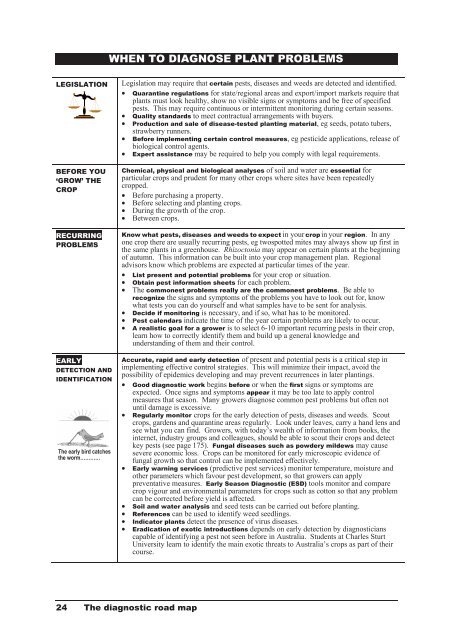PLANT PROTECTION 4
PLANT PROTECTION 4
PLANT PROTECTION 4
You also want an ePaper? Increase the reach of your titles
YUMPU automatically turns print PDFs into web optimized ePapers that Google loves.
LEGISLATION<br />
BEFORE YOU<br />
‘GROW’ THE<br />
CROP<br />
RECURRING<br />
PROBLEMS<br />
EARLY<br />
DETECTION AND<br />
IDENTIFICATION<br />
The early bird catches<br />
the worm…………<br />
WHEN TO DIAGNOSE <strong>PLANT</strong> PROBLEMS<br />
Legislation may require that certain pests, diseases and weeds are detected and identified.<br />
Quarantine regulations for state/regional areas and export/import markets require that<br />
plants must look healthy, show no visible signs or symptoms and be free of specified<br />
pests. This may require continuous or intermittent monitoring during certain seasons.<br />
Quality standards to meet contractual arrangements with buyers.<br />
Production and sale of disease-tested planting material, eg seeds, potato tubers,<br />
strawberry runners.<br />
Before implementing certain control measures, eg pesticide applications, release of<br />
biological control agents.<br />
Expert assistance may be required to help you comply with legal requirements.<br />
Chemical, physical and biological analyses of soil and water are essential for<br />
particular crops and prudent for many other crops where sites have been repeatedly<br />
cropped.<br />
Before purchasing a property.<br />
Before selecting and planting crops.<br />
During the growth of the crop.<br />
Between crops.<br />
Know what pests, diseases and weeds to expect in your crop in your region. In any<br />
one crop there are usually recurring pests, eg twospotted mites may always show up first in<br />
the same plants in a greenhouse. Rhizoctonia may appear on certain plants at the beginning<br />
of autumn. This information can be built into your crop management plan. Regional<br />
advisors know which problems are expected at particular times of the year.<br />
List present and potential problems for your crop or situation.<br />
Obtain pest information sheets for each problem.<br />
The commonest problems really are the commonest problems. Be able to<br />
recognize the signs and symptoms of the problems you have to look out for, know<br />
what tests you can do yourself and what samples have to be sent for analysis.<br />
Decide if monitoring is necessary, and if so, what has to be monitored.<br />
Pest calendars indicate the time of the year certain problems are likely to occur.<br />
A realistic goal for a grower is to select 6-10 important recurring pests in their crop,<br />
learn how to correctly identify them and build up a general knowledge and<br />
understanding of them and their control.<br />
Accurate, rapid and early detection of present and potential pests is a critical step in<br />
implementing effective control strategies. This will minimize their impact, avoid the<br />
possibility of epidemics developing and may prevent recurrences in later plantings.<br />
Good diagnostic work begins before or when the first signs or symptoms are<br />
expected. Once signs and symptoms appear it may be too late to apply control<br />
measures that season. Many growers diagnose common pest problems but often not<br />
until damage is excessive.<br />
Regularly monitor crops for the early detection of pests, diseases and weeds. Scout<br />
crops, gardens and quarantine areas regularly. Look under leaves, carry a hand lens and<br />
see what you can find. Growers, with today’s wealth of information from books, the<br />
internet, industry groups and colleagues, should be able to scout their crops and detect<br />
key pests (see page 175). Fungal diseases such as powdery mildews may cause<br />
severe economic loss. Crops can be monitored for early microscopic evidence of<br />
fungal growth so that control can be implemented effectively.<br />
Early warning services (predictive pest services) monitor temperature, moisture and<br />
other parameters which favour pest development, so that growers can apply<br />
preventative measures. Early Season Diagnostic (ESD) tools monitor and compare<br />
crop vigour and environmental parameters for crops such as cotton so that any problem<br />
can be corrected before yield is affected.<br />
Soil and water analysis and seed tests can be carried out before planting.<br />
References can be used to identify weed seedlings.<br />
Indicator plants detect the presence of virus diseases.<br />
Eradication of exotic introductions depends on early detection by diagnosticians<br />
capable of identifying a pest not seen before in Australia. Students at Charles Sturt<br />
University learn to identify the main exotic threats to Australia’s crops as part of their<br />
course.<br />
24 The diagnostic road map







![[Compatibility Mode].pdf](https://img.yumpu.com/27318716/1/190x135/compatibility-modepdf.jpg?quality=85)









